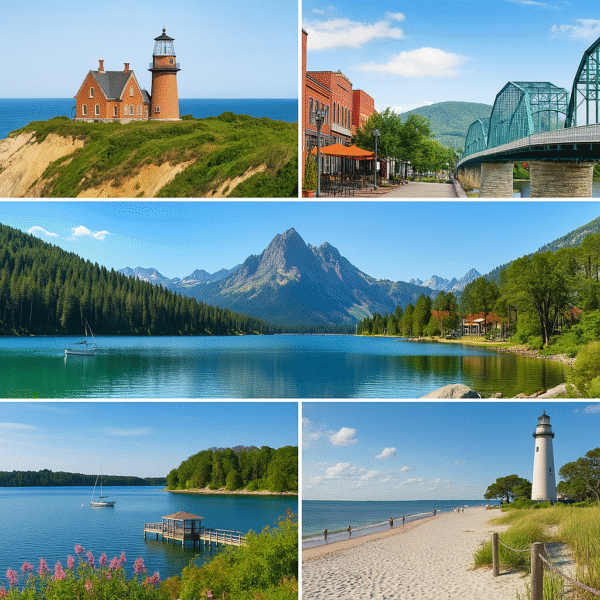As overtourism intensifies in major U.S. hotspots like New York, Las Vegas, and the Grand Canyon, travelers are increasingly seeking quieter, more meaningful vacation alternatives. According to the latest report by U.S. News & World Report, five under-the-radar destinations are emerging as traveler favorites in 2025: Block Island (Rhode Island), Chattanooga (Tennessee), Door County (Wisconsin), Sawtooth National Recreation Area (Idaho), and St. Simons Island (Georgia). These places are reshaping American tourism by offering natural beauty, historical charm, and stress-free travel experiences.
1. Block Island, Rhode Island: East Coast Serenity
Just 13 miles off the Rhode Island coast, Block Island is often overshadowed by its glitzier New England neighbors, Nantucket and Martha’s Vineyard. But its 17 miles of pristine public beaches, dramatic coastal bluffs, and relaxed pace make it a haven for travelers looking for peace and authenticity.
Attractions like the Southeast Lighthouse and Mohegan Bluffs offer Instagram-worthy views, while the Block Island Maritime Institute provides educational insights into the island’s marine biodiversity. With eco-tourism growing, the island’s nature reserves and biking trails are increasingly popular with environmentally conscious tourists.
According to the Rhode Island Commerce Corporation, Block Island contributes significantly to the state’s coastal tourism revenue, particularly during summer months when ferry services are in full swing.
2. Chattanooga, Tennessee: Southern Charm Meets Outdoor Thrills
Nestled in southeastern Tennessee along the Tennessee River, Chattanooga—nicknamed the “Scenic City”—is quietly becoming a magnet for adventure tourism. It’s home to one of the longest pedestrian bridges in the world (Walnut Street Bridge), the acclaimed Tennessee Aquarium, and nearby attractions like Rock City Gardens and Ruby Falls atop Lookout Mountain.
Affordable accommodations and a walkable downtown filled with murals, artisan eateries, and historic landmarks make Chattanooga ideal for families and budget travelers.
According to Tennessee Department of Tourist Development, Chattanooga’s tourism industry supports over 8,000 jobs and generates millions annually in visitor spending. A blend of history, culture, and outdoor recreation has firmly placed it on the radar of travelers avoiding the Nashville–Atlanta crowd.
3. Door County, Wisconsin: The Midwest’s Quiet Coastal Gem
Known as the “Cape Cod of the Midwest,” Door County is nestled between Green Bay and Lake Michigan. With six state parks, 300 miles of shoreline, and quaint towns like Fish Creek and Ephraim, the peninsula offers a rich blend of nature, food, and local art.
Visitors can enjoy cherry-picking in spring, kayaking through limestone sea caves in summer, and cross-country skiing in winter. Door County’s charming inns and farm-to-table restaurants reflect the region’s focus on slow, sustainable tourism.
Data from the Wisconsin Department of Tourism shows that Door County generated more than $430 million in economic impact in 2023 alone, with year-round travel helping to stabilize seasonal employment and preserve small business culture.
4. Sawtooth National Recreation Area, Idaho: America’s Alpine Secret
Located in central Idaho, the Sawtooth National Recreation Area (SNRA) spans over 756,000 acres and features more than 700 miles of trails and 300+ alpine lakes. Redfish Lake, one of its most iconic spots, offers opportunities for boating, fishing, and swimming against the backdrop of jagged peaks.
Unlike the crowded trails of Yosemite or Yellowstone, Sawtooth’s wide-open spaces cater to solitude-seekers, backcountry hikers, and wildlife watchers. The U.S. Forest Service has invested in improving trail access and conservation efforts as visitor interest surges.
Tourism-related businesses in nearby towns like Stanley and Ketchum have seen consistent growth, according to the Idaho Department of Commerce, with nature-based tourism driving up hospitality revenues and outdoor gear sales.
5. St. Simons Island, Georgia: Southern Elegance by the Sea
Part of Georgia’s Golden Isles, St. Simons Island blends white-sand beaches with Southern history and charm. From Civil War battlegrounds and the storied St. Simons Lighthouse to moss-draped oaks lining the island’s roads, the destination exudes timeless tranquility.
With mild temperatures year-round, activities like biking, golfing, and kayaking keep visitors engaged while avoiding the over-commercialized feel of other beach towns. The Golden Isles Convention & Visitors Bureau reports steady annual growth in tourism, with over $150 million in local spending in recent years.
Efforts to preserve the island’s fragile ecosystems through initiatives like the St. Simons Land Trust ensure that sustainable tourism remains a top priority.
Why These Places Matter for the Future of U.S. Tourism
As travel habits shift post-pandemic, these five destinations illustrate a growing demand for authenticity, environmental stewardship, and local engagement. The combination of natural beauty, affordability, and community-driven tourism initiatives is reshaping how Americans and international visitors experience the U.S.
Tourism officials across these regions have noted a significant uptick in interest due to social media exposure and word-of-mouth. Influencers seeking peaceful landscapes, families looking for safer, uncrowded retreats, and travelers concerned with sustainability are driving this movement.
Furthermore, local economies are seeing tangible benefits—from the growth of small hospitality businesses and artisanal shops to increased funding for conservation projects and public infrastructure.
Final Thoughts
In 2025, these five underrated U.S. travel destinations are proving that you don’t need to visit the most famous cities or national parks to have an unforgettable journey. Whether it’s the alpine tranquility of Idaho, the coastal serenity of Rhode Island, or the cultural heartbeat of Tennessee, each location offers a slice of America that’s authentic, engaging, and quietly spectacular.
For travelers seeking less-traveled paths and communities aiming for tourism that sustains rather than overwhelms, these destinations aren’t just alternatives—they’re the future.
For more travel news like this, keep reading Global Travel Wire






















